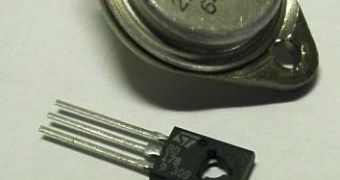Scientists at the United States National Institute of Standards and Technology (NIST) have recently discovered a fundamental flaw in our understanding of transistor noise, which is a phenomenon that appears inside a transistor's on and off switch. The team that found the problem says that, unless solved, the issue will prevent engineers from creating smaller and more advanced such devices in the future. Cell phones, computer processors, and pacemakers are but a few of the currently existing devices that could benefit from smaller transistors, and their development is currently blocked by this problem.
The elastic tunneling model (ETM), which has until now governed the way engineers designed these hardware components, may soon be rendered completely obsolete, the team shares. It has found evidence that this model, which has been in use to explain certain anomalous behavior inside the transistors, such as for instance sudden variations between the on and off states, simply does not fit the facts the experts inferred from direct measurements.
According to the ETM, the smaller the transistors get, the more often the fluctuations between the two states should occur. But Jason Campbell, an expert from NIST who worked on studying the devices, explains that, even at the nanoscale, the frequency of these variations does not increase, as predicted. “This implies that the theory explaining the effect must be wrong. The model was a good working theory when transistors were large, but our observations clearly indicate that it's incorrect at the smaller nanoscale regimes where industry is headed,” he tells.
However, Campbell adds, it would appear that the rate of fluctuations increases as the level of power decreases, which is a “real bottleneck in our development of transistors for low-power applications. We have to understand the problem before we can fix it – and troublesomely, we don't know what's actually happening,” he pinpoints. Overcoming this problem could result in mobile phones that run for more than a week on the same charge, or in pacemakers that would need to have their batteries changed only once per decade.
The finds were inferred by the NIST team, working together with fellow researchers from the University of Maryland College Park and the Rutgers University, and were presented on May 19th, in Austin, Texas, at a specialized conference. In conclusion, they maintain, the further development of low-power transistors is in question, until better ways of overcoming this issue, or at least predicting its effects, are not devised.

 14 DAY TRIAL //
14 DAY TRIAL //